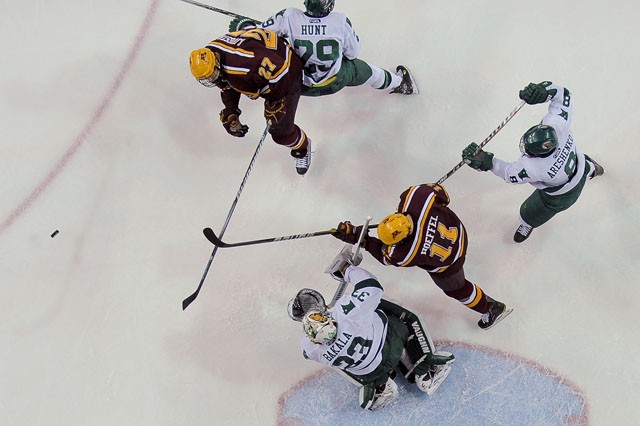On March 8, Boston Bruins defenseman Zdeno Chara raced up the ice alongside Montreal Canadiens forward Max Pacioretty. Chara, 6-foot-9 and 260 pounds, lowered his shoulder and forced Pacioretty into a stanchion between the teamsâÄô benches.
Pacioretty collapsed, motionless on the ice; a few hours later he was diagnosed with a severe concussion and a fractured vertebra.
The Montreal police investigated the incident, but Chara received no suspension from the NHL, a decision that was supported by many around the league.
In recent years, rule changes and advances in helmet technology have aimed to reduce concussion rates in hockey. Yet catastrophic hits continue, and experts disagree about how âÄî or even if âÄî concussions can be prevented.
âÄúItâÄôs probably the injury thatâÄôs our biggest concern,âÄù Gopher Sports medical director Bradley Nelson said. âÄúAs we start to look at data in youth hockey injuries, concussions are probably much more common than we previously thought.âÄù
At issue, however, is the proper way to reduce the prevalence of head injuries. Medical professionals and referees diverge as to whether rule or equipment changes are the proper catalyst.
Forty-four percent of NHL concussions in the 2010-11 season have been the result of legal hits, 26 percent from accidental contact, and only 17 percent from contact the league would consider illegal, according to a recent report by the NHLâÄôs hockey operations department. Nelson said that further rule modifications and overall better enforcement can reduce the rate of concussions.
Greg Shepherd, supervisor of officials for the WCHA, disagrees.
âÄúWe have enough current rules to keep players safe,âÄù Shepherd said. âÄúIllegal contact to the head is a five minute major and checking from behind is that plus an immediate game misconduct with possibility of suspension.âÄù
The real problem, Shepherd said, is improperly worn equipment.
âÄúChin guards and helmets missing straps or being left unfastened is far too common,âÄù he said. Shepherd offered a seemingly counterintuitive idea to diminish âÄúcheapâÄù hits and unnecessary contact to the head, specific to college hockey.
âÄúGet rid of the full cage mask,âÄù Shepherd said. The cage is a metal piece which covers the playerâÄôs entire face with bars spaced enough apart for clear visibility. This piece of equipment is mandatory at all youth hockey levels, including high school and college.
The cage mask is optional in the NHL and is rarely used. Instead, many players wear whatâÄôs known as a half-shield or visor produced from polycarbonate, a strong plastic. The rest of league doesnâÄôt wear any type of helmet mask.
How could removing the cage reduce concussions?
âÄúBring respect back to the game,âÄù Shepherd said. âÄúWith a half-shield players would keep their sticks and elbows down away from the head, knowing whatever they do could just as easily happen to them. With the cage, players become to reckless thinking they are fully protected.âÄù
Nelson, however, cites research that equipment modification would not be effective in suppressing head injuries.
âÄúConcussions are a rotational injury,âÄù Nelson said. âÄúTechnology doesnâÄôt exist at this time to prevent this, and might not for some time. Current helmets are made to prevent catastrophic injuries, which they do.âÄù
As the most influential hockey organization in the U.S., Nelson feels it is exceedingly important for the NHL to set a good example for its youth followers, particularly in enforcing rules related to hits to the head.
New enforcement in this realm is something the NHL has addressed recently, with the advent of Rule 48 preventing blind-side hits to the head in March 2010.
A more recent example is Pittsburgh Penguins forward Matt Cooke, who was suspended for 10 regular-season games as well as the first round of playoffs, for his elbow to the head of the New York RangersâÄô Ryan McDonagh. The league made an example of Cooke, considering suspensions lasting into the postseason are nearly unheard of.
At the very least, CookeâÄôs extended suspension encapsulates a shift in attitude throughout a sports world beginning to understand the lasting and devastating effects of head injuries.
âÄúI received a concussion but was back on the ice a week later,âÄù Art Miller, a member of North DakotaâÄôs 1959 national championship team, said. âÄúShould I have been? Maybe not, but those were different times.âÄù









